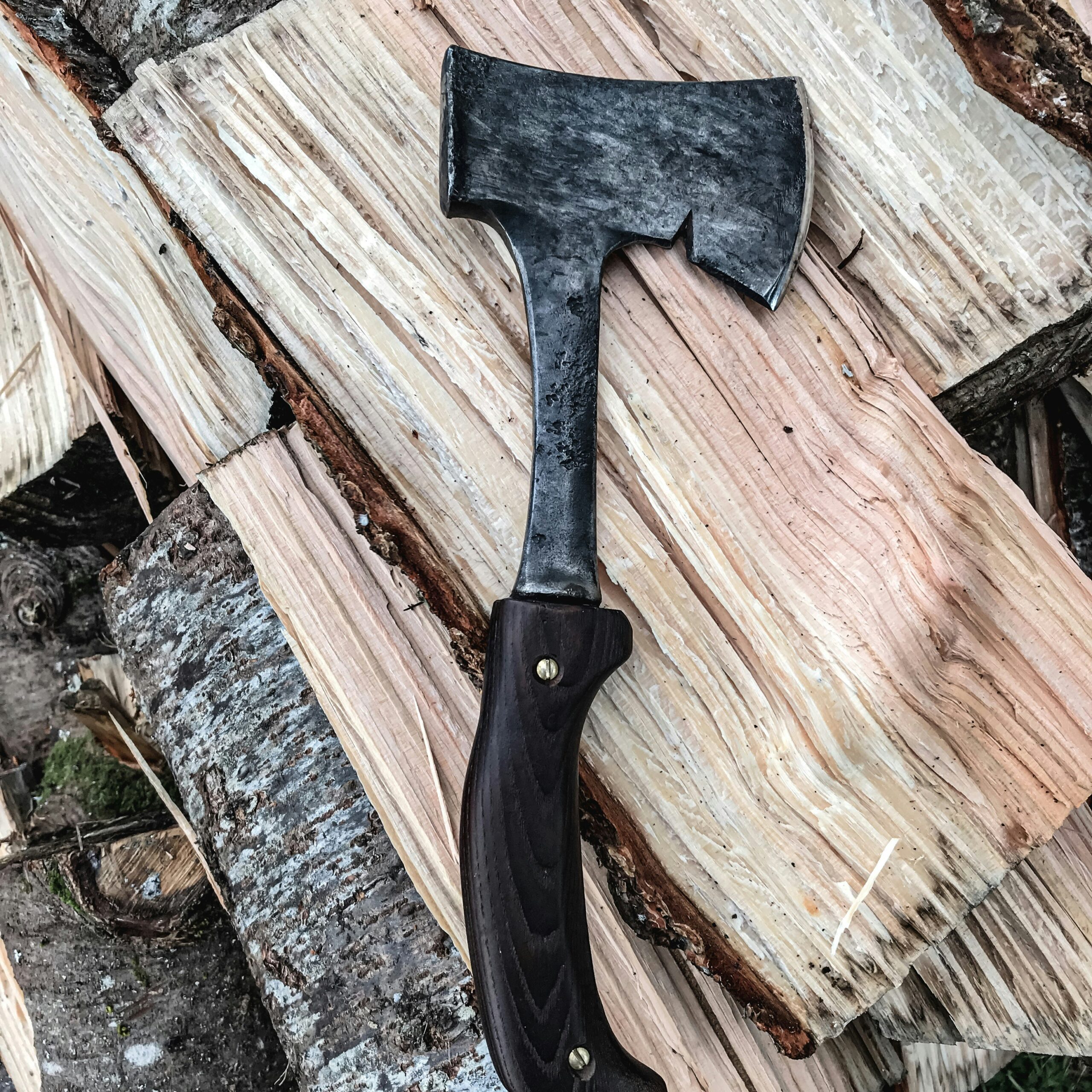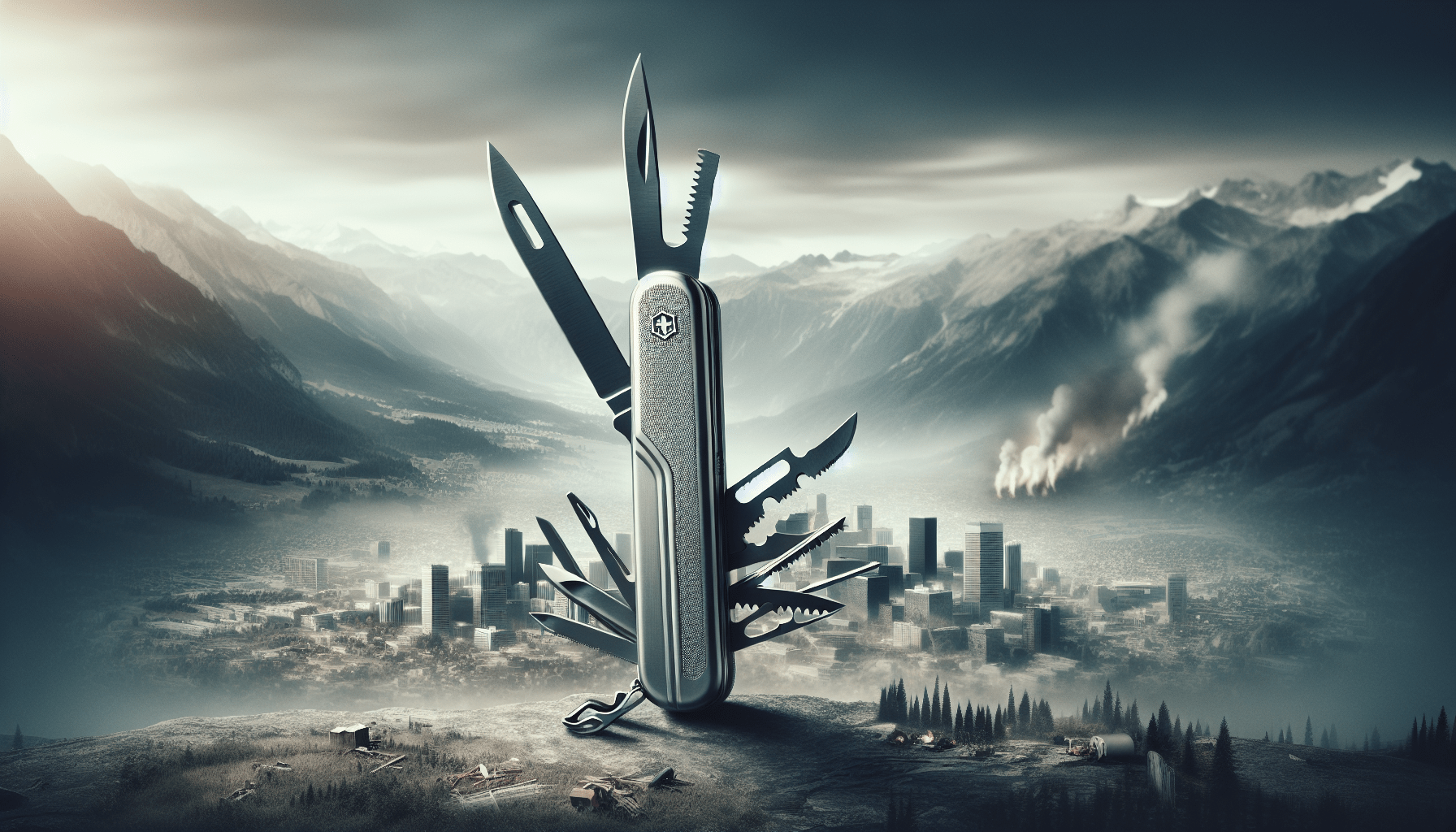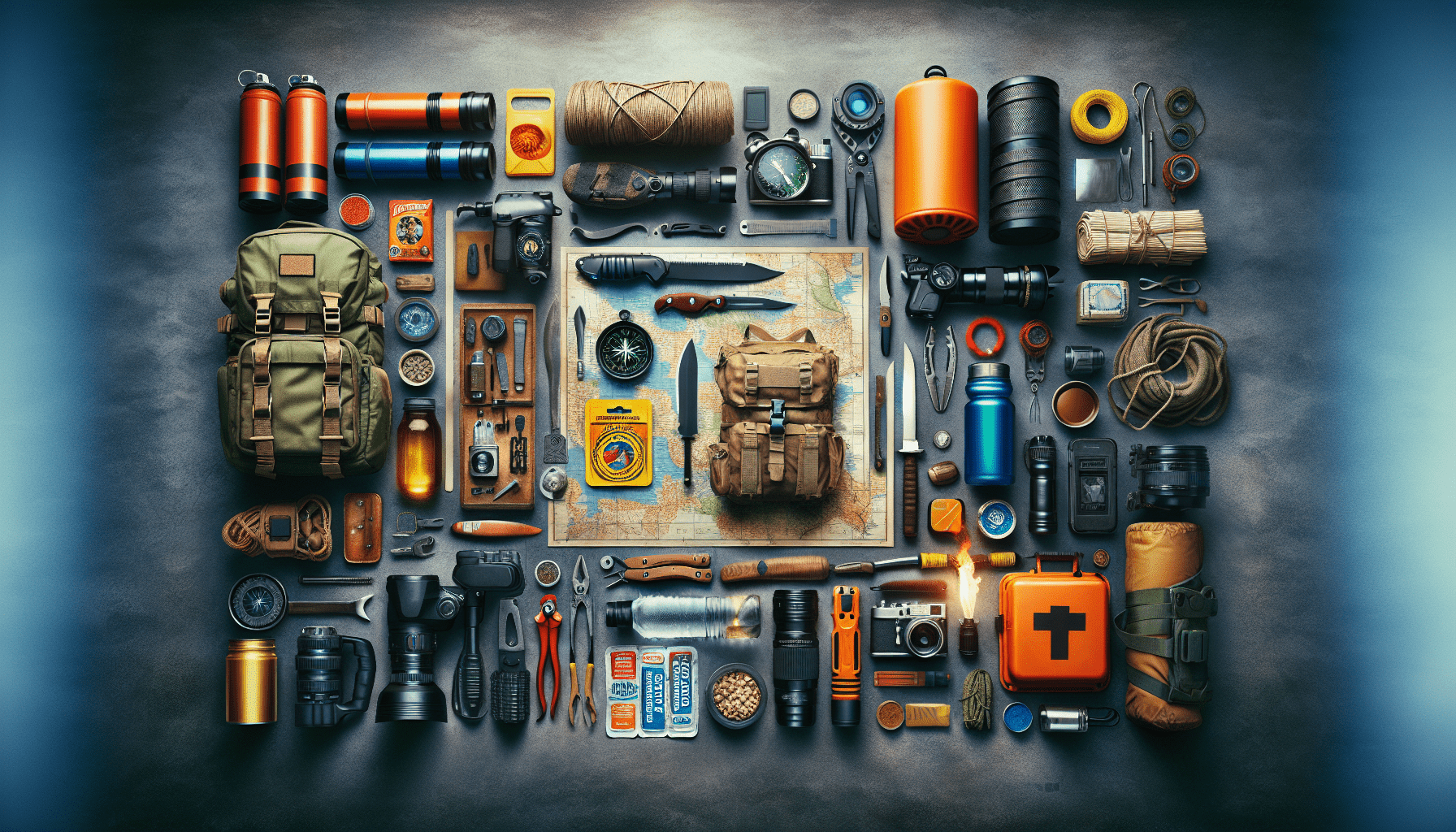In times of societal disruption or natural disaster, being prepared can make all the difference in your survival. That’s why we’ve compiled the essential list of survival tools to help you navigate through these challenging situations. From the tools necessary for ensuring food and clothing, to finding shelter and protecting yourself, this comprehensive list has got you covered. So, whether you’re facing a power outage, extreme weather conditions, or any other unexpected event, rest assured knowing you have the necessary tools to overcome and thrive.
Water Purification Tools
Portable water filters
Portable water filters are essential tools for ensuring access to clean and safe drinking water in survival situations. These filters use advanced technology to remove harmful bacteria, protozoa, and other contaminants from water sources such as rivers, lakes, and even questionable tap water. Compact and lightweight, portable water filters are easy to carry and can provide up to hundreds of gallons of purified water. They are a must-have for any emergency preparedness kit.
Water purification tablets
In situations where carrying bulky filtration devices might not be practical, water purification tablets offer a lightweight and convenient alternative. These tablets contain chemicals such as chlorine or iodine that effectively kill or neutralize harmful microorganisms, making the water safe to drink. They are easy to use, simply requiring the tablet to be added to a container of water and left for a specific amount of time to take effect. Water purification tablets are a reliable backup option for purifying water when other methods are not available.
Boiling equipment
Boiling water is one of the oldest and most reliable methods of water purification. Having a portable stove or a camping pot with a lid in your survival kit allows you to effectively treat water by bringing it to a rolling boil for at least one minute. Boiling water kills most types of pathogens and is a simple yet highly effective way to ensure safe drinking water in emergency situations.
Water storage containers
To store purified water and ensure its availability during a survival situation, having durable and leak-proof water storage containers is crucial. Look for containers made from food-grade materials that are approved for long-term water storage. Collapsible water containers are a great option as they are lightweight and easy to pack. Ensure you have enough containers to store an adequate amount of water for you and your family’s needs, keeping in mind that the recommended amount is at least one gallon per person per day.
Food Procurement Equipment
Fishing gear
When it comes to procuring food in a survival situation, fishing gear is an invaluable tool. A fishing rod, fishing line, hooks, and various types of bait can help you catch fish from nearby bodies of water. It is important to familiarize yourself with local fishing regulations and learn different fishing techniques to increase your chances of a successful catch. Fishing gear is lightweight, compact, and easily portable, making it an ideal addition to your survival kit.

Hunting weapons
In situations where you may need to rely on hunting for sustenance, having appropriate hunting weapons becomes essential. Depending on the local regulations and your level of experience, hunting rifles, bows, and arrows, or even slingshots can be effective tools for procuring food. Make sure to practice proper hunting techniques and safety precautions to ensure ethical and responsible hunting practices.
Gathering tools
Gathering edible plants, fruits, and nuts from the wild can provide an additional food source in survival situations. Having a set of gathering tools such as a folding saw, gardening gloves, and a sturdy backpack can make the process more efficient and comfortable. It is crucial to educate yourself on local flora and fauna to identify edible plants and berries accurately.
Emergency food supplies
While relying on natural food sources is ideal, it is also essential to have emergency food supplies as a backup plan. Non-perishable food items like canned goods, energy bars, and dried fruits can provide nourishment when fresh food sources are scarce. Aim for a well-balanced and diverse selection of food items that can meet your nutritional needs and have a long shelf life.
Clothing and Weather Protection Tools
Insulation clothing items
In survival situations, maintaining proper body temperature is crucial for your overall well-being. Insulation clothing items such as thermal base layers, fleece jackets, and down-filled vests help trap body heat and provide additional warmth. Look for materials that are moisture-wicking, quick-drying, and lightweight to ensure maximum comfort and insulation.
Waterproof boots and gloves
Protecting your feet and hands from moisture is essential in survival situations to prevent frostbite and other cold-weather-related injuries. Invest in high-quality waterproof boots with good traction and insulation to keep your feet dry and warm. Additionally, waterproof gloves or mittens will help retain heat while allowing you to perform tasks requiring dexterity, such as gathering firewood or setting up shelter.

Hats to protect against sun or cold
A hat is a versatile accessory that provides protection against both the sun and cold temperatures. In sunny conditions, a wide-brimmed hat can shield your face and neck from harmful UV rays. In colder environments, a beanie or a thermal hat can help retain body heat by keeping your head warm. Choose hats made from breathable and moisture-wicking materials for maximum comfort.
Sunglasses for eye protection
Sunglasses are often overlooked but are crucial for protecting your eyes from harmful UV rays and glare. In snowy or high-altitude environments, the sun’s reflection can be particularly intense and cause damage to your eyes. Choose sunglasses with UV protection and polarized lenses to reduce glare and enhance visibility in various weather conditions.
Shelter-Making Tools
Tents
A reliable and sturdy tent is an essential tool for providing shelter and protection from the elements in survival situations. Look for a tent that is lightweight, easy to set up, and made from durable materials. Consider the desired capacity, seasonality, and weather resistance of the tent when making your selection.
Tarpaulins
Tarpaulins are versatile and lightweight tools that can be used to create additional shelter or as a ground cover. They can be easily laid out and secured with ropes to protect against rain and wind. Additionally, they can be used as makeshift awnings or as a temporary roof in emergency situations.
Sleeping bags
Having a good quality sleeping bag is crucial for staying warm and comfortable during nights in the wilderness. Look for sleeping bags with adequate insulation and temperature ratings suitable for your expected weather conditions. Consider factors such as weight, portability, and ease of packing when choosing a sleeping bag.

Hammocks
Hammocks provide a lightweight and portable alternative to traditional tents and can be a great option for survival situations in warm climates. They are easy to set up, offer comfort above the ground, and can double as a shelter with the addition of a tarpaulin or a mosquito net. Ensure you choose a sturdy and durable hammock that can support your weight and provides proper insulation.
Light Sources
Flashlights
Having reliable and durable flashlights is essential for navigating in the dark and maintaining visibility in low-light conditions. Look for flashlights with long battery life, adjustable beam settings, and waterproof features. It is advisable to have multiple flashlights and spare batteries in your survival kit.
Headlamps
Headlamps offer hands-free lighting and are particularly useful for tasks that require both hands, such as setting up camp or cooking. Look for headlamps with adjustable brightness settings and comfortable headbands. Consider models with red light settings to preserve night vision and avoid attracting insects.
Solar powered lights
Solar-powered lights are an environmentally friendly and sustainable lighting solution for survival situations. They utilize solar panels to convert sunlight into electricity and can provide hours of illumination. Look for models with efficient solar charging capabilities and multiple lighting modes, including a low-energy mode to conserve battery life.
Matches and lighters
Traditional fire-starting tools such as matches and lighters are indispensable for creating fire for warmth, cooking, and signaling. Store matches in a waterproof container or invest in windproof lighters to ensure reliability in adverse conditions. It is always a good idea to include multiple fire-starting tools and store them in different locations within your survival kit.
Communication Equipment

Emergency radios
During a societal disruption or a natural disaster, staying informed is crucial for your safety and well-being. Emergency radios, powered by hand-cranking or solar charging, allow you to receive important weather updates, news broadcasts, and emergency alerts. Look for models with multiple power options and a built-in flashlight for added functionality.
Satellite phones
In situations where traditional communication networks may be down or unreliable, satellite phones provide a means of communication for emergency situations. They operate using satellite signals and allow you to make calls and send messages from remote locations. Satellite phones can be expensive and require a subscription or pre-paid plans, but they can be life-saving in critical situations.
Whistles
A simple yet effective tool, a loud whistle can help attract attention and alert others to your presence in emergency situations. Whistles are lightweight, compact, and easy to carry. Attach a whistle to your backpack or wear it around your neck for quick access in case of emergencies.
Signal mirrors
Signal mirrors are used to reflect sunlight and create a visible signal to communicate with rescuers or passing aircraft. These small, lightweight mirrors are typically made of highly reflective material and come with sighting aids to assist in aiming the mirror accurately. It is essential to practice using a signal mirror to increase the chances of successful signaling during emergencies.
Navigation Tools
Compasses
A compass is an essential tool for navigation, helping you determine direction and orient yourself in unfamiliar terrain. Look for a durable and reliable compass with clear markings and a liquid-filled housing for accurate readings. Familiarize yourself with basic compass usage and navigation techniques to effectively navigate through challenging environments.

GPS devices
Global Positioning System (GPS) devices provide accurate and detailed navigation information, making them valuable tools in survival situations. Look for handheld GPS devices with long battery life, durability, and pre-loaded maps or the ability to download maps for offline use. Familiarize yourself with GPS usage and learn to navigate using coordinates to maximize the benefits of this technology.
Maps of local and surrounding areas
Even with GPS technology, carrying detailed maps of the local and surrounding areas is crucial for backup navigation and planning. Look for topographic maps that provide detailed information about the terrain, landmarks, and water sources. Familiarize yourself with map symbols and learn to read maps effectively to ensure accurate navigation.
Star Charts
In situations where traditional navigation tools might be unavailable, star charts can be used to determine direction using celestial objects. Star charts provide information about the positions of stars, constellations, and other celestial bodies in the night sky. Familiarize yourself with basic astronomy concepts and learn to identify key stars to navigate using this ancient yet reliable method.
First Aid Supplies
Bandages and medical tape
First aid supplies are crucial for treating injuries and medical emergencies in survival situations. Make sure your first aid kit includes a variety of bandages in different shapes and sizes, as well as medical tape for securing dressings and providing support. Look for hypoallergenic and adhesive bandages to minimize skin irritation.
Antiseptic creams and wipes
Antiseptic creams and wipes help prevent infection in wounds and promote proper healing. Include antibiotic ointments, alcohol wipes, and antiseptic solutions in your first aid kit to clean and disinfect wounds. Consider adding sterile saline solution for eye irrigation and wound cleansing.
Pain relievers and medications
Having pain relievers such as acetaminophen or ibuprofen can provide relief from aches, pains, and fevers. Include any necessary prescription medications you or your family members rely on to manage chronic conditions. Make sure to regularly check expiration dates and replenish your first aid supplies as needed.
Emergency blankets
Emergency blankets, also known as space blankets, are lightweight, compact, and highly reflective. They are designed to retain body heat and provide insulation in emergency situations. These blankets can be used to protect against hypothermia or provide shade in hot climates. Ensure you have multiple emergency blankets in your kit to accommodate multiple individuals.
Defense and Protection
Firearms and ammunition
In extreme survival situations where self-defense may be necessary, firearms can provide a means of protection. It is crucial to obtain proper training and familiarize yourself with local laws and regulations regarding firearms ownership and usage. Store firearms and ammunition securely and responsibly, keeping them out of reach of children and unauthorized individuals.
Pepper spray
Pepper spray, also known as OC spray, is a non-lethal self-defense tool that can temporarily incapacitate an attacker. It is small, easy to carry, and widely available for personal use. Familiarize yourself with local laws and regulations regarding pepper spray possession and usage and follow safety instructions when deploying it.
Knives
A versatile and essential tool, a knife has numerous survival uses, from cutting food and rope to building shelter and self-defense. Invest in a high-quality, fixed-blade knife with a sturdy handle and a strong, sharp blade. Learn proper knife-handling techniques and safety precautions to avoid accidents and injuries.
Multi-tool
A multi-tool combines several functionalities into one compact and portable device. Look for a multi-tool with a knife, pliers, screwdrivers, can opener, and other handy tools. This versatile tool can be a valuable asset in a survival situation, offering solutions to various challenges and tasks.
Multipurpose Tools and Supplies
Duct tape
Duct tape is a versatile and multi-purpose tool that can be used for emergency repairs, improvising shelters, securing items, and many other applications. Pack a small roll of duct tape in your survival kit to have a reliable and durable adhesive solution readily available.
Rope or cord
Rope or cordage is an essential tool for building shelters, securing equipment, and creating makeshift tools. Look for ropes made from durable materials such as nylon or paracord, which have high tensile strength and are resistant to wear and tear. Consider including different lengths and thicknesses of rope to accommodate various needs.
Multi-tool gadget
A compact and lightweight gadget that incorporates multiple tools and functions into one unit can be a valuable addition to your survival kit. Examples include credit card-sized multi-tools with features like a knife, screwdriver, can opener, and ruler. These gadgets are easily portable and can provide practical solutions to unexpected challenges.
Portable solar charger
In situations where traditional power sources may be unavailable, a portable solar charger can be a lifesaver. These devices use solar energy to charge batteries or power electronic devices such as phones, GPS devices, and flashlights. Look for durable, weather-resistant models with efficient solar charging capabilities to stay connected and powered up in critical situations.
In conclusion, being prepared for a societal disruption or natural disaster requires having the essential tools for survival. Water purification tools ensure access to clean and safe drinking water, while food procurement equipment helps procure food from various sources. Clothing and weather protection tools keep you warm, dry, and protected from the elements, and shelter-making tools provide a safe place to rest. Light sources, communication equipment, and navigation tools aid in orientation and communication with the outside world. First aid supplies help address injuries and medical emergencies, while defense and protection tools provide security. Finally, multipurpose tools and supplies offer versatility and solutions to various challenges. By equipping yourself with these essential tools, you increase your chances of survival and overall well-being in challenging situations. Remember to regularly review and replenish your supplies to ensure readiness in times of need. Stay prepared, stay safe!

